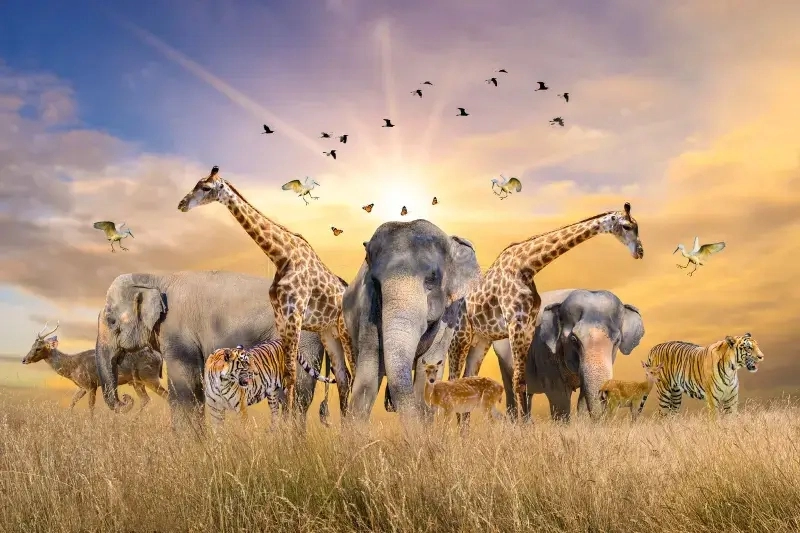Hello Everyone, Our world, Earth, is a living testament to the boundless creativity of nature. It is an intricate mosaic, woven together with countless threads of life, each thread representing a unique animal species. From the tiniest insects to the largest mammals, Earth’s biosphere is a spectacle to behold.
In this extensive exploration, we embark on a journey to fathom the depths of Earth’s biodiversity and endeavor to answer the intriguing question: Just how many animals are there on our planet?
How Many Animals Are in the World?

Chapter 1: The Challenge of Counting Life
Before we delve into the quest to determine the number of animals on Earth, we must acknowledge the herculean task at hand. Earth’s biological diversity is staggering, and cataloging every species is akin to piecing together an immense, intricate puzzle. This endeavor is beset with challenges, from the remoteness of some habitats to the constant discovery of new species and the vastness of our planet.
Chapter 2: The Known Species
As of the last reliable estimate available in 2021, scientists had identified approximately 8.7 million species on Earth. Within this astonishing array of life, approximately 86,000 species are classified as vertebrates, including mammals, birds, reptiles, amphibians, and fishes. The majority of Earth’s biodiversity, however, is comprised of invertebrates, which encompass a dizzying array of creatures ranging from insects and arachnids to mollusks and crustaceans.
Chapter 3: The World of Microorganisms
While we often celebrate the diversity of macroscopic life, we must not overlook the hidden universe of microorganisms. Microbes, minuscule single-celled organisms, form an integral part of Earth’s ecosystems. Astonishingly, the true number of microbial species remains an enigma, with estimates ranging from thousands to possibly millions. These microbes, often invisible to the naked eye, play crucial roles in nutrient cycling, decomposition, and even in human health.
Chapter 4: The Uncharted Seas
As we gaze at the terrestrial realm, we must also turn our attention to the vast expanses of the world’s oceans, which cover over 70% of the Earth’s surface. The oceans remain a realm of uncharted mysteries, harboring an astounding diversity of life. It is believed that more than 80% of marine species remain undiscovered by science. The abyssal depths, coral reefs, and even the darkest ocean trenches hold secrets yet to be unveiled.
Chapter 5: The Symphony of Conservation
While we marvel at the sheer multitude of Earth’s animals, we must not lose sight of the fact that many species teeter on the brink of extinction. Human activities, such as habitat destruction, pollution, and climate change, threaten the delicate balance of life on our planet. Conservation efforts are paramount to safeguarding the biodiversity that graces our world.
Chapter 6: A Humanized Perspective
Beyond the statistics and figures, it is essential to humanize our understanding of Earth’s animals. Each species possesses a unique role in the intricate web of life, contributing to the resilience and stability of ecosystems. From the charismatic elephants of Africa to the humble-bees that pollinate our crops, every creature plays a part in the symphony of nature.
Must Read:- Exploring (10 Different Species)
The most populous animal species
The title of the most populous animal species on Earth belongs to a creature that, while small and often unnoticed, plays a vital role in maintaining the balance of our ecosystems: the Antarctic krill (Euphausia superba). These tiny, shrimp-like organisms thrive in the frigid waters of the Southern Ocean, forming colossal swarms that can stretch for miles. Despite their diminutive size, collectively, Antarctic krill populations are estimated to number in the trillions.
These minuscule marvels serve as a cornerstone of the marine food web, providing sustenance for a wide range of animals, from whales to penguins. The sheer abundance of Antarctic krill highlights the interconnectedness of all life on Earth and underscores the importance of preserving these delicate ecosystems. While they may be small, Antarctic krill play an outsized role in the grand tapestry of life, reminding us of the intricate web of biodiversity that sustains our planet.
The least populous animal species
The title of the least populous animal species on our planet introduces us to a poignant and sobering aspect of our natural world. Among the countless creatures that grace the Earth, some species teeter on the brink of extinction, their populations dwindling to critically low numbers. These are the rarest of the rare, and they deserve our utmost attention and protection.
One such example is the vaquita (Phocoena sinus), often referred to as the world’s most endangered marine mammal. Native to the Gulf of California, these diminutive porpoises have faced a catastrophic decline in their numbers, with estimates suggesting that fewer than 10 individuals remain in the wild. The primary threat to their survival is accidental entanglement in fishing nets, making conservation efforts a race against time to save this unique species from vanishing forever.
Another candidate for the title of the least populous animal species is the Javan rhinoceros (Rhinoceros sondaicus). These majestic creatures once roamed across Southeast Asia but are now confined to the Ujung Kulon National Park in Indonesia, with a population estimated to be around 70 individuals. Poaching and habitat loss have driven these rhinos to the brink of extinction, highlighting the urgent need for dedicated conservation measures.
As we reflect on these critically endangered species, it becomes evident that the fate of the least populous animals rests in our hands. Conservation efforts, habitat protection, and raising awareness about these endangered species are crucial steps towards ensuring their survival. Each of these creatures represents a unique thread in the tapestry of life on Earth, and it is our responsibility to ensure that they continue to grace our planet for future generations to admire and cherish.
How many animals will there be in the future?
Predicting the exact number of animals that will exist in the future is a complex task influenced by numerous factors. One of the most significant determinants is the impact of human activity. As the global population continues to rise, we exert greater pressure on natural resources, leading to habitat destruction and fragmentation. Without effective conservation measures, this can result in the decline of many animal species.
Climate change is another critical factor affecting animal populations. Altered weather patterns, rising temperatures, and sea-level rise can disrupt ecosystems and challenge the survival of species adapted to specific climatic conditions.
However, there is hope. Growing awareness of conservation issues has led to increased efforts to protect endangered species and their habitats. Conservation organizations, governments, and communities worldwide are collaborating to preserve biodiversity, potentially stabilizing or even increasing certain animal populations in the future.
In a more optimistic scenario, advancements in technology and sustainable practices could help mitigate negative impacts on animal populations. Initiatives like wildlife corridors, captive breeding programs, and sustainable resource management offer hope for the preservation of many species.
The future of Earth’s animal populations is dynamic and intricate. While we can’t predict exact numbers, we can influence the outcome through responsible stewardship, conservation efforts, and sustainable practices. It is a shared responsibility to humanize our approach, recognizing that each species contributes to the intricate tapestry of life on our planet.
Also Read:-
- What Animals Start with the Letter N?
- African Wildlife: A Beginner’s Guide to the Big Five
- Top 10 Birds in Africa
- Types of dragons
- What do lions eat?
Conclusion
So, how many animals are there in the world? The answer, though elusive and ever-evolving, paints a portrait of Earth as a realm teeming with life, awaiting discovery and appreciation. As stewards of this astonishing biodiversity, we bear the responsibility of safeguarding and cherishing the animals that coexist with us.
Through conservation efforts, an unwavering appreciation for the marvels of nature, and a commitment to preserving Earth’s precious biodiversity, we can ensure that the animals of our planet continue to thrive, inspiring generations to come. In doing so, we embark on a profound journey of discovery and appreciation for the wonders of our world.

